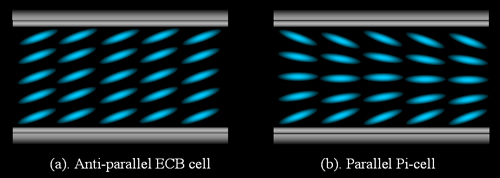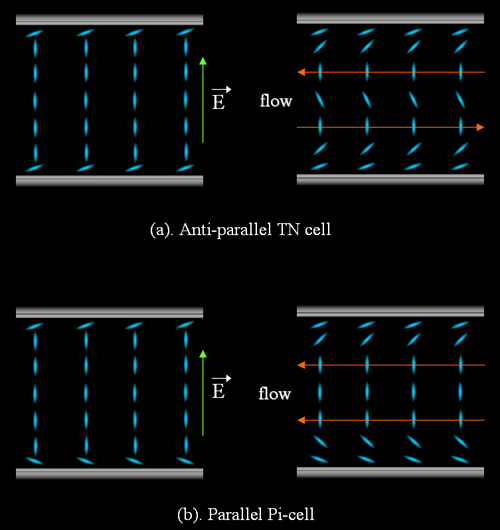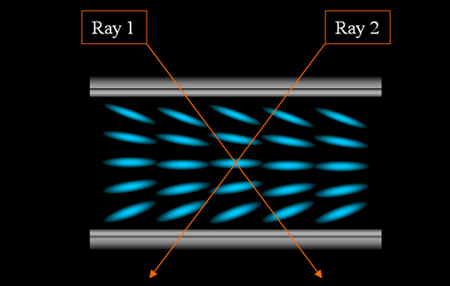¡¡[Pi-Cell (Optically Compensated Bend - OCB) mode]
The idea of Pi-cell was first proposed by P.
Bos in 1984,
it utilizes the backflow to speed up the switching process. It is also known
as Optically Compensated Bend.
In the conventional Freedericksz ECB cells have a uniform
alignment of molecules with a pretilt angle in the opposite direction on two
substrates, also called anti-parallel alignment of substrates, as shown in figure
1, after the electric field is switched on and then off, the molecules start
to relax back to the original state, causing a flow. The molecules in the
mid-layer feel a torque, which causing a back-flow of the material and trying to
rotate them through a large angle to the original state. However this slow down
the switching speed.

Figure 1.
Comparison between conventional ECB cell and Pi-cell.
In the Pi-cell, the pretilt angles on both substrates are
in the same direction, also called parallel alignment of substrates. When the
field is switched off, the molecules in the mid-layer no longer feel the torque
during relaxing to the off state. The angle to tilt back is small, caused a
faster switching speed.

Figure 2. Flow
direction comparison between conventional TN cell and Pi-cell.
The back-flow can cause the optical bounce in the
electro-optical response to a rectangular waveform pulses; this bounce increases
the off time. In stead in the Pi-cell, no such bounce exists, hence a faster
switching off is obtained.
The Pi-cell cell has an
intrinsic wide viewing angle because of the self-compensated structure, as shown
in figure 3, light ray 1 and 2 passing the two oblique incidence directions
experience the same retardation.

Figure 3. Wide
viewing angle from the self-compensation nature of the Pi-cell.
However this self-compensation
nature is not valid for incidence out of the the director plane. Moreover, the
on-axis contrast ratio (CR) is low because of the residual birefringence even at
high voltage; therefore optical compensation films are required for high CR and
wide viewing angle. P. Bos et al. proposed a method of compensation for
the cell using a negative birefringence film with the optic axis in the normal
direction (negative C-plate) in 1993. In the same year, using biaxial films for
optical compensation was proposed by Yamaguchi et al.
To obtain the bend structure of
the cell, an electric field with amplitude above the splay to bend transition
voltage must be applied. However, the transition from splay to bend structure
takes a long time, typically, in the order of tens of seconds. Another issue is
that splay domains appear at the regions with weak electric field in a
complicated electrode pattern. These problems associated with the bend alignment
stabilization were solved after the efforts of LCD researchers and
manufacturers. The first commercial Pi-cell (OCB) panel is now available in the
market.
Further Readings
and References:
P. J. Bos and K. R.
Koehler-Beran, Mol. Cryst. Liq. Cryst. 113, 329 (1984).
Y. Yamaguchi, T.
Miyashita and T. Uchida, "Wide-viewing-angle display mode for the
active-matrix LCD Using bend-alignment liquid-crystal cell", SID'93
Dig., pp. 273-276 (1993).
P. J. Bos and J. A.
Rahman, ¡°An optically ¡¯self-compensating¡¯ electro-optical effect
with wide angle of view",,¡± in SID¡¯93 Dig., vol. 273, (1993).
¡¡